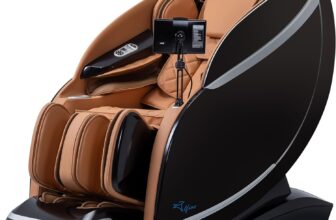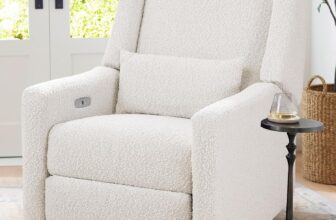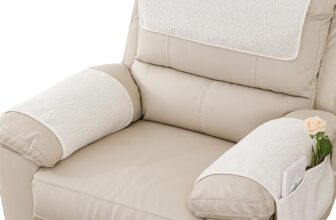4 Best Oversized Wall Hugger Recliners in 2026
SIn homes where space is a premium but comfort can’t be compromised, oversized wall-hugger recliners offer a practical and inviting solution. These cleverly designed recliners require only a few inches of clearance from the wall, making them ideal for apartments, smaller living rooms, or bedrooms where every foot counts. Yet despite their compact footprint, they deliver generously on space and support. The oversized dimensions cater especially well to taller or broader individuals, offering a deeper seat, extended footrest, and wider arm span—all without dominating the room. High-density foam, reinforced frames, and easy-to-operate reclining mechanisms provide durability and comfort, whether for reading, recovering, or late-night TV. Look for models with power recline options and USB ports for added functionality. If you value both form and function, an oversized wall-hugger recliner is a smart investment that blends coziness with thoughtful engineering—fitting perfectly into your lifestyle, and your floor plan.
4 Best Oversized Wall Hugger Recliners in 2025
(1) Signature Design by Ashley Tip-Off Casual Wall Hugger Power Recliner
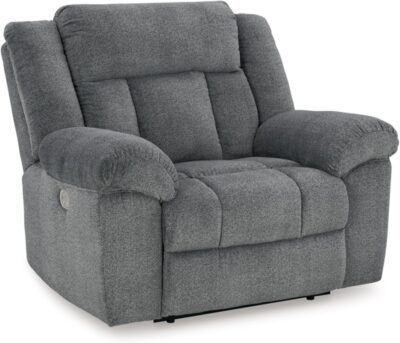
“Adjustable headrest is a game changer for me.” – Tony
This chair showed up two days earlier than expected, which was a nice surprise. While the assembly instructions weren’t the clearest, I’ve built enough furniture to figure it out without much hassle. Once it was set up, I was impressed. I’m 6’5” and 220 lbs, and it supports me really well—this thing is huge! The soft fabric feels great, and the whole build feels solid. The headrest adjustment has been a big win for me, and though the footrest moves a bit slowly, it’s not a dealbreaker. The recline mechanism is smooth and quiet. It’s so roomy that two average-sized people can sit together comfortably, which is not something you get with most recliners. I also love that it doesn’t scream “recliner” at first glance—it has a more modern, cozy look. Made in Vietnam, and honestly, most good furniture is these days. All in all, I’m really happy with it.
(2) Signature Design by Ashley Dunleith Zero Wall Recliner with Power Headrest
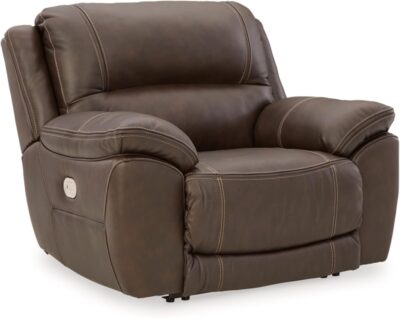
“It is easier getting up from seated position because his knees/legs are at 90 degrees rather than previous Ashley recliner” – abigail h
Unboxed the recliner in under five minutes and had it fully set up just as fast—super straightforward assembly. It’s only two pieces: plug in the cords, slide the back into place, and you’re done. The size feels just right—spacious without being overbearing. The leather has a solid feel to it, and the stitching looks sharp and durable. The seat? Firm, which I actually prefer. I’ve learned the hard way that too-soft furniture doesn’t hold up well. It starts cozy and ends up saggy. This feels like it’s made to last. The recline function works smoothly, and it looks much sleeker than most bulky recliners out there. I’ve already got my eye on the matching Dunleith sectional to go with it. Overall, I’m really happy I took the leap. It checks all the boxes: clean design, solid build, and comfort that’ll only get better with time.
(3) Power Lift Recliner Sofa with Massage and Heat
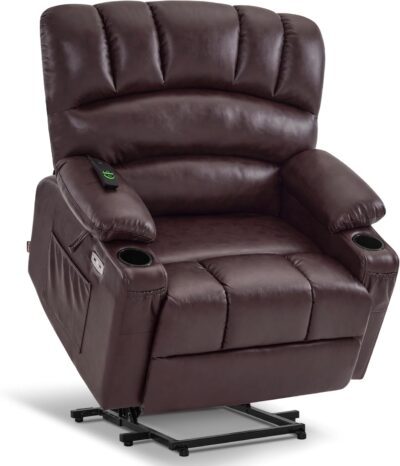
first hand user review “The chair was elegant to fit into my Mom’s living room, comfortable even without the extra heat/massage feature, the lift really helped her get up and down, and the price was very reasonable. My Mom loves her new chair and I love this company!!“
The functions on the remote are just a little too complicated for the elderly people to use. This spacious chair comfortably accommodates me and my dog. The smooth recline operation and effective, though slightly less robust, massage function add to its appeal. While the seat isn’t as deep as expected, it’s perfectly comfortable when reclined.
(4) Watson & Whitely Genuine Leather Power Recliners
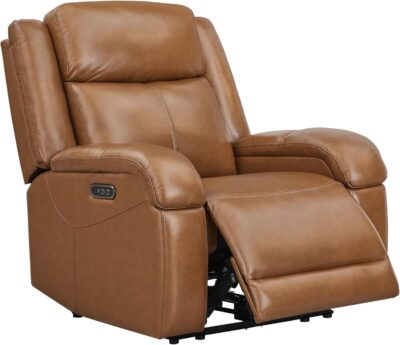
first hand user review “It was easy to unpack, assembly was very easy and accomplished in 20 minutes. This is a genuine all leather recliner with a USB-C port. The leather is gorgeous, the power mechanism is smooth quiet and quick.” — Foodie
This wall hugger recliner is an excellent space-saving solution. It features three buttons for precise adjustments to the leg, back, and headrest. The built-in USB-C is perfect for charging your phone, tablet, or laptop. The actuator operates quietly and smoothly, while the leather/vinyl is soft. The cushions are firm yet comfortable, providing the ideal balance for relaxation.
7 Things to Consider Before Buying Oversized Wall Hugger Recliners
1) How much wall clearance does it actually need?
An oversized wall-hugger recliner is built with one mission in mind—save space without sacrificing comfort. But when you’re dealing with limited square footage, even the slightest misunderstanding about how far it needs to sit from the wall can throw off your entire room layout.
So how much wall clearance does it actually need?
Despite the name “wall hugger,” most models still require at least 2 to 4 inches of clearance between the back of the recliner and the wall. Some high-end or cleverly engineered models might get away with just 1 inch, but that’s rare. Compare that to traditional recliners, which can need 12 inches or more—a significant difference when you’re fitting furniture into a small living room or apartment.
The key feature behind the wall-hugger’s design is a forward-glide mechanism. Instead of leaning backward into a recline and pushing the chair’s back into the wall, the seat itself moves forward on a track, allowing the back to tilt without physically shifting closer to the wall. This motion preserves that critical rear clearance and keeps your paint unscuffed.
But here’s where it gets tricky: “oversized” models, by nature, have broader frames and deeper seats, which sometimes means their recline angle is wider, and thus may require closer to 4–5 inches of space—especially for full recline positions like zero gravity or extended leg rests. So if you’re measuring for tight corners, don’t just look at the manufacturer’s dimensions; always check the full recline footprint. Most product pages list this, but if not, reach out directly to the manufacturer or retailer.
Another point to keep in mind: flooring type. On carpets, these heavy recliners tend to shift less, but on hardwood or tile, even a half-inch of slide during recline could send the chair scraping against your wall. Use nonslip pads if necessary.
Bottom line: Even the most compact wall-hugger recliners need at least 2 inches, but plan for 3–4 inches for larger models. Measure twice, trust the specs, and never assume “wall-hugger” means “zero clearance.” It doesn’t.
2) So, will it fit through your doorway or staircase?
That’s one of the most important questions to ask before you hit “Buy”—and one too many people forget until the recliner is stuck halfway through the door.
Start by checking the shipping dimensions, not just the assembled ones. Most oversized wall-hugger recliners ship in multiple pieces—typically the backrest comes detached from the base, which helps significantly with maneuverability. If the recliner comes in one solid box, though, you’ll need to pay very close attention to the width, height, and depth of the packaged unit.
Standard interior doorways in most homes are about 30 to 36 inches wide. If your recliner’s widest piece (usually the base) is less than 29 inches wide, it will likely slide through fine, especially if you turn it sideways. For tighter spaces like stairwells or hallway corners, pay attention to both length and the turning radius—you’ll want to know whether it can pivot around tight landings or corners.
Ask the seller or manufacturer:
- Does the recliner ship in two parts?
- What are the exact dimensions of each part?
- Are there instructions for detaching armrests or legs for tight squeezes?
Real-World Tip:
If you live in an apartment or older house, bring out the measuring tape and actually measure the doorway—including the doorstop trim. Don’t just estimate. Also, check overhead clearances for light fixtures, especially on stairs, and make sure you can safely turn corners with bulky furniture.
And don’t forget: You can always remove the door temporarily to gain an extra inch or two of clearance.
Bottom line: Most oversized wall-hugger recliners will fit through doorways if shipped in parts, but always double-check the dimensions. Being proactive saves you the heartbreak—and the backache—on delivery day.
3) How deep is the seat and how firm is the cushion?
—Two deceptively simple questions that can make or break your relationship with a recliner.
Let’s start with seat depth, because comfort begins with how well your body fits the chair. A deeper seat—anything above 22 inches—tends to suit taller users (think 5’10” and up). It lets them sit back fully with proper thigh support. But for shorter individuals, a seat that deep may cause the feet to dangle, placing pressure on the lower back and reducing circulation. Most oversized recliners lean toward deeper seats by default, so it’s crucial to check whether your feet comfortably touch the floor when seated. If they don’t, even the plushest chair becomes tiring over time.
Now, cushion firmness. This is where preference and posture collide.
Most oversized recliners today are made with high-density foam cores—some topped with memory foam, others wrapped in fiberfill. Manufacturers often market their chairs as “plush,” but that word is vague. What you want to know is:
- Will it hold up after 6 months of daily use?
- Does it support your lower back and hips?
- Does it sag under your weight, or provide a balanced push-back?
A firmer seat is better for posture, especially if you plan to sit for hours reading, watching TV, or working from the recliner. Softer cushions, on the other hand, may feel inviting at first but tend to break down faster, leading to a lopsided or hollow seat base over time.
Real-world comparison:
I once tested two similar recliners—one with a 20-inch seat depth and firm cushion, and another with a 24-inch depth and ultra-soft padding. The former was less “cushy” on first sit, but after a week of long sessions working from home, it was the one I kept. The deeper, softer chair felt indulgent—but it swallowed my frame and forced me to slouch.
Takeaway:
Measure your thigh length. Sit in a few recliners if you can. Ask for the cushion density rating (anything around 1.8 lbs per cubic foot is standard for durability). In the end, the right combination of depth and firmness is what transforms a recliner from something you use to something you never want to get out of.
4) Does it truly support my height and weight?
—A critical question too often glossed over in favor of looks and features.
The truth is, not all recliners are built equal—and neither are we. A chair that looks plush and inviting in a showroom may feel like an awkward perch at home if it doesn’t match your body’s proportions. For taller individuals (6 feet and above), leg and neck support are where the shortcomings often begin to show. If your head extends past the top cushion or your feet dangle awkwardly when reclined, the chair simply isn’t doing its job. And that’s not just about comfort—it’s about long-term spinal alignment and pressure relief.
Most manufacturers list weight capacity—usually between 250 to 350 pounds for standard models, and up to 500 pounds for heavy-duty or “big and tall” options. But don’t just take that number at face value. A recliner may technically hold your weight, but if it sags, creaks, or shifts when you lean back, that’s a red flag for durability and structural integrity. Look for reinforced steel frames, sinuous spring systems, and high-density foam—all indicators the chair is built to last, not just survive a showroom demo.
Take note of seat width and height as well. If you’re on the broader side, you’ll want a chair with at least 20–24 inches of seating space. For taller users, a seat height of 18–21 inches from the floor tends to hit the sweet spot for natural posture and easy transitions in and out of the chair. Armrest height also matters; if they’re too low, your shoulders will slump. Too high, and your arms will stay unnaturally lifted.
A real-world moment:
A reader once shared how she ordered a sleek faux-leather recliner online for her 6’4” husband—only to discover the footrest stopped at mid-shin and the headrest landed at his upper back. The recliner wasn’t broken. It just wasn’t designed for him.
The takeaway:
Buy for your body, not the catalog image. Check the specs, read reviews from people your size, and if possible, test in-store. A good recliner should make you feel anchored, supported, and balanced—not floating, sinking, or compensating. After all, comfort isn’t just about how soft something feels. It’s about how well it holds you, day after day.

